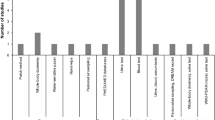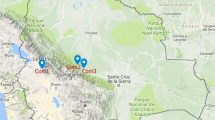Abstract
Aim
The focus of this review is to highlight the evidence of the take-home pathway as an additional and substantial route of exposure for children of farm workers. Possible exposure of older children during farm work is not discussed.
Subject
A critical examination of papers published during the last 15 years concerning this subject was performed.
Methods
An extensive literature search of the most recent papers was carried out to identify papers describing and reporting circumstances of pesticide exposure among “agricultural workers’ children”. Exclusion criteria included papers older than 1990, those reporting pesticide exposures that occurred among residential settings, pesticide intake with diet (or dietary pesticide exposure) and any pesticide exposure related to individuals other than children (i.e. workers, consumers, bystanders). The data from a total of 11 studies which carried out environmental or biological, or both, sampling have been organised into tables.
Results
Findings showed evidence of higher pesticide exposure for children of agricultural workers compared with those of non-agricultural workers. This could not be entirely explained by the proximity factor; outcomes suggested that a “take-home” pathway exists and contribute to increasing the indoor contamination of pesticide residues, thus the potential for exposure of children. Further, estimated scenarios indicated that non-dietary ingestion of pesticide residues could lead to intake that exceeds US Environmental Protection Agency (USEPA) oral chronic reference doses (RfD) (and even European Union acceptable daily intake).
Conclusions
Although hardly anything can be done with the proximity factor, improving farm workers’ hygiene and correcting some improper behaviour could turn into a considerable benefit for children’s health.
Similar content being viewed by others
References
Aprea C, Strambi M, Novelli MT et al (2000) Biologic monitoring of exposure to organophosphorus pesticides in 195 Italian children. Environ Health Perspect 108(6):521–525
Azaroff LS (1999) Biomarkers of exposure to organophosphorous insecticides among farmers’ families in rural El Salvador: factors associated with exposure. Environ Res 80(2 Pt 1):138–147
Bearer CF (1995) How are children different from adults? Environ Health Perspect 103(Suppl 6):7–12
Bradman MA, Harnly ME, Draper W et al (1997) Pesticide exposures to children from California’s Central Valley: results of a pilot study. J Expo Anal Environ Epidemiol 7(2):217–234
Coronado GD, Thompson B, Strong L et al (2004) Agricultural task and exposure to organophosphate pesticides among farmworkers. Environ Health Perspect 112(2):142–147
Curl CL, Fenske RA, Kissel JC et al (2002) Evaluation of take-home organophosphorus pesticide exposure among agricultural workers and their children. Environ Health Perspect 110(12):A787–A792
Curwin B, Sanderson W, Reynolds S et al (2002) Pesticide use and practices in an Iowa farm family pesticide exposure study. J Agric Saf Health 8(4):423–433
Curwin BD, Hein MJ, Sanderson WT et al (2005) Pesticide contamination inside farm and nonfarm homes. J Occup Environ Hyg 2(7):357–367
Ecobichon DJ (2001) Pesticide use in developing countries. Toxicology 160(1–3):27–33
Ekstrom G, Hemming H, Palmborg M (1996) Swedish pesticide risk reduction 1981–1995: food residues, health hazard, and reported poisonings. Rev Environ Contam Toxicol 147:119–147
Eskenazi B, Bradman A, Castorina R (1999) Exposures of children to organophosphate pesticides and their potential adverse health effects. Environ Health Perspect 107(Suppl 3):409–419
European Commission—DG Health and Consumer Protection (updated October 2006) (http://ec.europa.eu/food/plant/protection/evaluation/stat_active_subs_3010_en.xls
Fenske RA, Lu C, Barr D et al (2002) Children’s exposure to chlorpyrifos and parathion in an agricultural community in central Washington State. Environ Health Perspect 110(5):549–553
Garry VF (2004) Pesticides and children. Toxicol Appl Pharmacol 198(2):152–163
Gladen BC, Sandler DP, Zahm SH et al (1998) Exposure opportunities of families of farmer pesticide applicators. Am J Ind Med 34(6):581–587
Jurewicz J, Hanke W (2006) Exposure to pesticides and childhood cancer risk: has there been any progress in epidemiological studies? Int J Occup Med Environ Health 19(3):152–169
Koch D, Lu C, Fisker-Andersen J et al (2002) Temporal association of children’s pesticide exposure and agricultural spraying: report of a longitudinal biological monitoring study. Environ Health Perspect 110(8):829–833
Konradsen F, van der Hoek W, Cole DC et al (2003) Reducing acute poisoning in developing countries-options for restricting the availability of pesticides. Toxicology 192(2–3):249–261
Loewenherz C, Fenske RA, Simcox NJ et al (1997) Biological monitoring of organophosphorus pesticide exposure among children of agricultural workers in central Washington State. Environ Health Perspect 105(12):1344–1353
Lu C, Fenske RA, Simcox NJ et al (2000) Pesticide exposure of children in an agricultural community: evidence of household proximity to farmland and take home exposure pathways. Environ Res 84(3):290–302
Lu C, Kedan G, Fisker-Andersen J et al (2004) Multipathway organophosphorus pesticide exposures of preschool children living in agricultural and nonagricultural communities. Environ Res 96(3):283–289
Roberts DM, Karunarathna A, Buckley NA et al (2003) Influence of pesticide regulation on acute poisoning deaths in Sri Lanka. Bull World Health Organ 81(11):789–798
Rodriguez T, Younglove L, Lu C et al (2006) Biological monitoring of pesticide exposures among applicators and their children in Nicaragua. Int J Occup Environ Health 12(4):312–320
Simcox NJ, Fenske RA, Wolz SA et al (1995) Pesticides in household dust and soil: exposure pathways for children of agricultural families. Environ Health Perspect 103(12):1126–1134
Sumner D, Langley R (2000) Pediatric pesticide poisoning in the Carolinas: an evaluation of the trends and proposal to reduce the incidence. Vet Hum Toxicol 42(2):101–103
USEPA (1995) Integrated risk information system-IRIS http://www.epa.gov/iris/; accessed February 2007
World Health Organization (1990) Public health impact of pesticides used in agriculture. World Health Organization, Geneva
World Health Organization (1997) WHO assessment of exposure to indoor air pollutants. World Health Organization, Copenhagen
Acknowledgements
The authors would like to thank colleagues from ICPS: Ms. Virginia Zanzottera for providing support with bibliographic issues, Ms. Sara Visentin and Mr. Alessandro Chiodini for their indications about toxicological endpoints (ADI). Acknowledgements go also to Mr. Francesco Mitis from WHO-ECEH Rome for some suggestions on the “Methods” section.
Conflict of interest statement
The authors declare that there are no actual or potential conflicts of interest in relation to this article.
Author information
Authors and Affiliations
Corresponding author
Rights and permissions
About this article
Cite this article
Vida, P., Moretto, A. Pesticide exposure pathways among children of agricultural workers. J Public Health 15, 289–299 (2007). https://doi.org/10.1007/s10389-007-0127-z
Received:
Accepted:
Published:
Issue Date:
DOI: https://doi.org/10.1007/s10389-007-0127-z




